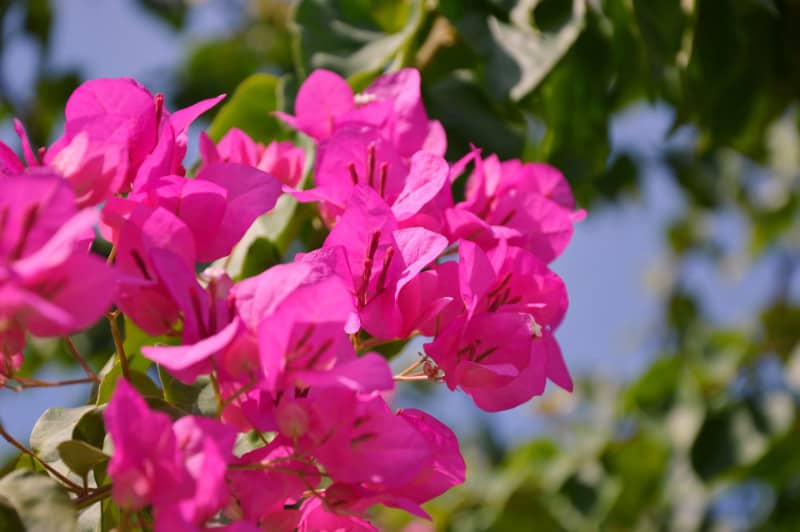If you’re looking for a low-maintenance flowering plant to add to your garden, look no further than four o’clocks. These easy-to-grow perennials come in a variety of colors, and they require very little care once they’re established. In this post, we’ll tell you everything you need to know about growing and caring for four o’clocks.
Best Four O’Clock Varieties
| Image | Name | Rating | Shop |
|---|---|---|---|
 | David’s Garden Seeds Flower Four O’Clock Pink | ||
 | Burpee Marbles Mix Four O’Clock Seeds | ||
 | Four O’clock Marvel of Peru, Mulit Colored Bloom |
How to Grow and Care for Four O’Clocks
Four O’Clocks Hardiness Zones
Four o’clocks (Mirabilis jalapa) are a beautiful but often underrated flowering plant. They are surprisingly hardy and can be grown as a perennial in zones 9–11. Everywhere else, they are usually replanted each season and grown as an annual.
How Much Sun Do Four O’Clocks Need
Four o’clocks need full to partial sun to flower well. They can tolerate some shade, but too much shade will cause the plant to become leggy and produce fewer flowers. Choose a spot in your garden that gets at least six hours of direct sunlight each day for the best results.
Four O’Clocks Soil Requirements
Four o’clocks prefer moist, well-drained soil and they do not tolerate drought very well. However, they can handle some neglect and can even survive in marginal soils.
Four O’Clocks Soil pH
Four O’Clocks need an acidic to neutral soil pH of 6.5 to 7.0 in order to thrive. Most garden soils fall within this range, but if you’re unsure about your soil’s pH level, testing it is easy and inexpensive. You can find pH testing kits at most home improvement stores or online (Click Here).
Four O’Clocks Plant Spacing
When it comes to spacing four o’clock plants, the general rule of thumb is to space them 2 to 3 feet apart. This will give them enough room to spread out and grow without crowding each other. Keep in mind that four o’clocks can spread up to 3 feet, so if you plant them too close together they may overcrowd each other as they mature.
Four O’Clocks Temperature Requirements
Four O’Clocks like plenty of sunshine and heat, so give them a place where they can get lots of direct sun. And they don’t do well in cold or windy conditions, so plant them in a protected area that doesn’t experience late frosts in the spring.
Four O’Clocks Fertilizer Requirements
As far as fertilizer requirements go, Four O’Clocks are not terribly demanding. A Balanced fertilizer every 2 to 4 weeks throughout the growing season should suffice. manure or compost can also be added to the soil before planting, which will help to provide some ongoing nutrition for the plants. Beyond that, just make sure to keep an eye on the plants and give them a little extra dose of high phosphorus fertilizer if they start to look a bit lackluster.
Four O’Clocks Water Requirements
Four O’Clocks need 1 inch of water per week. It’s important not to let them dry out, so if rain is scarce, consider watering them frequently or add a layer of mulch to help keep the soil moist.
Four O’Clocks Humidity Requirements
Most people think that four o’clocks (Mirabilis jalapa) are finicky plants that require high humidity, but this is not the case! Four o’clocks can handle a wide range of humidity levels as long as they get enough water. So if you’re having trouble with your four o’clocks wilting or not blooming, the problem is likely not low humidity but a lack of soil moisture.
Four O’Clocks Pests
Aphids are a common pest for Four O’Clocks. They feed on the leaves of the plant and can cause significant damage. If you see aphids on your plants, it’s important to take action to get rid of them.
There are several ways to get rid of aphids, including using insecticidal soap. You can also encourage natural predators of aphids, such as ladybugs or lacewings, to help control the population. If all else fails, you may need to use a pyrethrin-based pesticide to get rid of them.
Four O’Clocks Diseases
Rust can be a big problem for Four O’Clocks. Two types of rust commonly affect Four O’Clocks: white rust and brown rust.
If you’re having problems with rust on your Four O’Clocks, there are a few things you can do to help control it. First, try to improve air circulation around the plant by spacing it out more or trimming back any nearby plants that are crowding it. You can also try spraying the plant with a copper-based fungicide
















